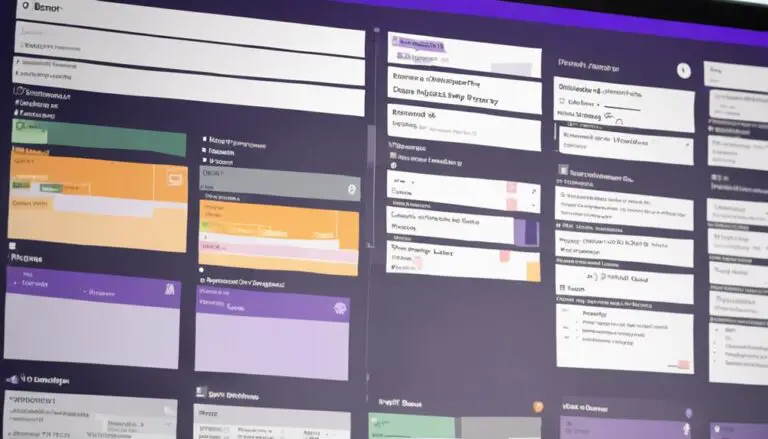In Kanban, the practice of utilizing user stories for effective planning is a pertinent point often pondered. But do these user stories truly hold the key to streamlined planning processes in Kanban? Kanban board use is an essential tool in implementing user stories for effective planning. By breaking down tasks into small, manageable stories, teams can easily prioritize and track their progress on the kanban board. This visual representation of work in progress allows for better collaboration and ensures that everyone is aligned on the team’s goals and priorities.
Let's explore how user stories serve as the backbone of Kanban methodology, aiding in prioritization and fostering collaboration within teams, ultimately leading to successful project outcomes.
The role of user stories in Kanban goes beyond mere documentation; they serve as a guiding light in the intricate web of project management.
Key Takeaways
- User stories in Kanban enhance planning precision and drive incremental development.
- User stories define system functionality with business value, improving collaboration.
- Prioritizing tasks based on user needs streamlines planning in Kanban.
- User stories focus on customer benefits, fostering collaboration and efficiency.
Understanding User Stories in Kanban
When working with Kanban, understanding user stories is crucial for effective planning and task management. User stories in Kanban are structured as 'As a [type of user], I want [goal], so that [customer benefit]' to represent system functionality. These user stories contain acceptance criteria that outline conditions for completing tasks. By focusing on customer needs, user stories enhance precision through verbal conversations, simplifying planning processes.
In Kanban, clear user stories ensure a common understanding within the team. This common understanding helps prioritize tasks effectively and guides development processes. User stories are adaptable to changes, promoting collaboration among team members. Collaborating on user stories not only fosters a sense of belonging within the team but also ensures that everyone is working towards the same goals. By incorporating user stories into Kanban practices, you can streamline your planning, improve task management, and ultimately deliver better results for your customers.
Role of User Stories in Kanban
To truly grasp the essence of Kanban's efficiency, understanding the pivotal role that user stories play within this methodology is paramount. Here's why user stories are integral to Kanban:
- User stories in Kanban represent pieces of system functionality with business value, focusing on user needs.
- Structured as 'As a [type of user], I want [goal], so that [customer benefit]', they drive incremental development.
- User stories help define details, document conditions for complete delivery, and enhance collaboration within the team.
- Clear user stories in Kanban improve precision, prioritize tasks effectively, and ensure the Agile framework is followed.
In Kanban, user stories serve as the backbone for effective planning, guiding teams towards delivering value in a collaborative and efficient manner. By leveraging user stories, teams can break down work into manageable chunks, prioritize tasks based on business value, and achieve incremental progress towards complete delivery.
Benefits of User Stories in Kanban
User stories in Kanban bring substantial benefits to the planning process, enhancing collaboration and driving value delivery efficiently. By defining system functionality that represents business value, user stories play a pivotal role in Kanban. They facilitate discussions, add granularity to project details, and capture conditions necessary for complete delivery within the Kanban framework.
These stories enhance precision through verbal exchanges, ensuring that planning is centered around meeting customer needs effectively. Moreover, clear user stories are instrumental in prioritizing tasks, estimating work accurately, and ultimately improving project efficiency in Kanban. Embracing user stories not only aids in delivering high levels of customer value but also fosters a culture of collaboration among team members.
In Kanban, the use of user stories is key to streamlining processes, enhancing communication, and achieving successful outcomes that align with business objectives.
Implementing User Stories in Kanban
Transitioning seamlessly into the implementation phase, you can embed user stories effectively within the Kanban framework by structuring them as 'As a [type of user], I want [goal], so that [customer benefit]' to signify their inherent business value.
To ensure successful implementation, consider the following:
- Define Acceptance Criteria: Clearly outline the conditions that must be met for each user story to be considered complete within the Kanban system.
- Engage in Conversations: Foster open dialogues among team members to refine user stories, elaborate on details, and establish acceptance criteria effectively.
- Conduct Testing: Validate user stories by testing them against the defined acceptance criteria to guarantee their successful completion in the Kanban workflow.
- Focus on Customer Value: Keep the user stories structured and prioritize those that deliver high levels of customer value, aligning with the continuous improvement ethos of Kanban.
Enhancing Planning With User Stories
Enhance your planning process in Kanban by leveraging the power of user stories to represent system functionality with tangible business value. User stories play a crucial role in Kanban by simplifying planning and prioritization based on customer needs.
They not only spur discussions but also help in fleshing out details and documenting conditions for complete delivery. By focusing on customer benefits and system functionality, user stories ensure that the team collaborates effectively to deliver high value to customers.
Through the structured format of user stories, Kanban teams can enhance their planning process, ensuring that every task contributes directly to the overall business value. By incorporating user stories into your Kanban workflow, you can streamline your planning process, increase collaboration, and prioritize tasks that align with customer needs, ultimately leading to successful and valuable project deliveries.
Frequently Asked Questions
Does Kanban Use User Stories?
Yes, Kanban uses user stories as the foundation for effective planning. Story mapping, task breakdown, backlog grooming, feature prioritization, sprint planning, and continuous delivery are key components. It fosters iterative development, customer feedback, and aligns with Agile methodology and the product roadmap.
Should You Use Story Points in Kanban?
In Kanban, you don't need story points for planning. Focus on efficiency, collaboration, and continuous improvement. Prioritize tasks together, visualize work, and use Kanban metrics for better flow. Skip the story points debate for now.
How Is Planning Done in Kanban?
In Kanban, planning involves estimating capacity, managing work in progress, breaking tasks down, tracking cycle time, striving for continuous improvement, using prioritization techniques, holding daily stand-ups, employing visual management, identifying bottlenecks, and fostering team collaboration for effective planning.
How Do I Create a User Story in Kanban Board?
To create a user story in Kanban, start with 'As a [type of user], I want [goal], so that [customer benefit]'. Discuss details with your team, define acceptance criteria, and test against them for completion on the board.
Conclusion
In conclusion, user stories are the building blocks of effective planning in Kanban, like pieces of a puzzle coming together to create a clear picture. By utilizing user stories, teams can collaborate, prioritize, and deliver customer value efficiently.
Just as a conductor orchestrates a symphony, Kanban orchestrates the flow of work with user stories, leading to harmonious outcomes and satisfied customers.
Let's keep crafting user stories to drive success in our Kanban journey together!





